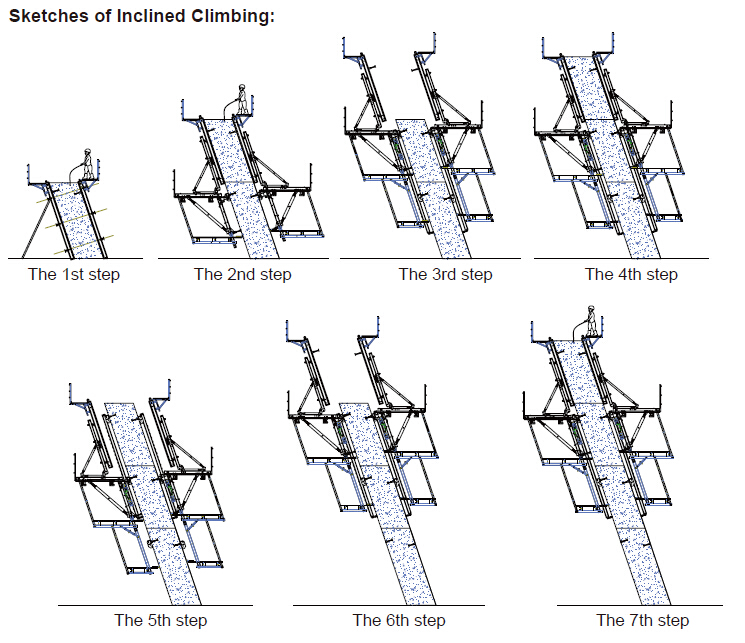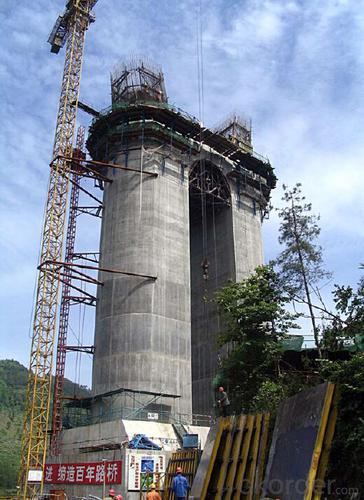Auto-Climbing Bracket ACB100 & ACB50 for formwork and scaffolding system
- Loading Port:
- Tianjin
- Payment Terms:
- TT OR LC
- Min Order Qty:
- 50 m²
- Supply Capability:
- 1000 m²/month
OKorder Service Pledge
OKorder Financial Service
You Might Also Like
Auto-climbing Bracket ACB100 & ACB50
The power of the auto-climbing formwork is the hydraulic system, which includes the oil cylinder
and two commutators. The commutators can control the climbing of climbing rail and the bracket.
The steel rail and the bracket can inter-climbing, so the whole system will climb up steadily.
Cranes are not needed during the construction. It’s easy to operate, highly efficient and safe. It’s
the best choice for the construction of high buildings and bridges.
There are mainly two types of standard auto-climbing brackets, ACB-50 and ACB-100, the figure
means the push power of cylinder with unit of KN.
Characteristics:
◆ Perfect load bearing anchor system
Anchor system is the most important supporting part. The system is made of five parts shown
below. Thereinto, tensile bolt, V-climbing cone and washer can be taken out for reusing after the
concrete pouring finished.There are two kinds of anchor systems,A & B. A is matched with single
anchor shoe and B is matched with double anchor shoe.
◆ Crane-independent
Crane-independent forming, striking and climbing speeds up the work procedures on the
construction site and also makes them independent of each other. This means the planned
sequences can be maintained along with guaranteeing high productivity levels. The crane can
therefore be used for other tasks.
Hydraulic system is mainly made of two commutators,
oil cylinder and power distribution system.The
commutators can control the climbing of climbing rail
and bracket.
◆ High bearing capacity and safe
The stable working platforms are able to carry large loads, e.g. the storage of reinforcing steel
for the next climbing section. Generously-sized working platforms, the well thought-out design for
handling very high wind loads and the patented control function of the climbing mechanism are
some of the special details contained within the comprehensive safety concept.
◆ Platforms adjusted to suit the angle of inclination
The horizontal working areas thus created provide safe and comfortable conditions for
reinforcement work, shuttering and striking, concreting and finishing.
◆ The ACB formwork system can climb not only vertically but also slantways, the largest angle is
18 degrees.
◆ The system can climb up wholly or separately. The climbing process is steady, synchronous
and safe.
◆ The bracket will not fall to the ground until the construction is finished, the field will be saved
and the impacting breakage will be reduced (especially the panel).
◆ The system will furnish omnidirectional platform, the construction organizations don’t need to
set up additional operation platform.
◆ The error of structure construction is small and easy to correct.
◆ The climbing speed is fast, the construction course will be quickened.
◆ The formwork can climb itself and cleaning work can be done in the same situs , the used times
of tower crane will be greatly reduced.

- Q: How does steel formwork handle different concrete pouring techniques?
- Steel formwork offers versatility and durability, making it an excellent option for various concrete pouring techniques. It possesses the strength and rigidity necessary to withstand the pressures exerted by different pouring methods, ensuring a stable and secure structure. One commonly used technique is gravity pouring, where concrete is poured into the formwork from above and allowed to flow downwards under its own weight. Steel formwork is highly suitable for this method as it effectively contains the concrete, preventing any leakage or spillage. The formwork's tight joints and sturdy panels ensure that the concrete remains in place and is evenly distributed throughout. Another technique is pumping, which involves using specialized equipment to pump concrete into the formwork. Steel formwork can handle this technique effectively, as it can withstand the force and pressure exerted during the pumping process. Its robust construction and reinforced edges provide the necessary support to contain the concrete and prevent any deformation or leakage. Steel formwork is also compatible with slip-forming, a technique that involves continuously pouring concrete into a moving formwork system. This method requires a formwork system that can be easily adjusted and adapted to changing shapes and heights. Steel formwork's modular design allows for quick and efficient adjustments, making it suitable for slip-forming applications. Additionally, its strength and stability ensure that the formwork remains intact during the continuous pouring process. In conclusion, steel formwork is a reliable choice for handling different concrete pouring techniques. Its strength, rigidity, and adaptability make it capable of withstanding the pressures and forces exerted by gravity pouring, pumping, and slip-forming methods. With steel formwork, builders and contractors can confidently execute various concrete pouring techniques, resulting in high-quality and structurally sound construction projects.
- Q: How is steel formwork different from other types of formwork?
- Steel formwork is different from other types of formwork primarily because it is made of steel, which provides superior durability, strength, and stability. Unlike traditional wooden formwork, steel formwork is reusable, ensuring cost-effectiveness and reduced waste. It is also highly adaptable, allowing for customization and flexibility in construction projects. Additionally, steel formwork offers a smooth surface finish, leading to enhanced quality and aesthetics of the final structure.
- Q: How does steel formwork handle different concrete reinforcement spacing?
- Steel formwork offers a versatile and robust solution for managing various reinforcement spacing in concrete structures. It consists of adjustable and flexible steel panels or frames, which can be customized to accommodate the specific spacing needed. The steel formwork panels possess multiple features that make them suitable for accommodating different reinforcement spacing. They come in various sizes and shapes, making it easy to adjust them to fit the desired spacing. Additionally, these panels are equipped with adjustable clamps or connectors, ensuring secure joining and providing stability and support for the concrete. When it comes to achieving the specific reinforcement spacing, steel formwork can be easily adapted. The steel panels can be positioned and aligned to create the desired spacing for the reinforcement bars. This can be achieved by adjusting the panels horizontally or vertically to meet the required distance between the bars. Moreover, steel formwork offers the necessary strength and durability to withstand the pressure exerted by the concrete during pouring and curing. This guarantees the formwork's integrity and stability, even when dealing with different reinforcement spacing. To sum up, steel formwork is well-suited for managing various reinforcement spacing in concrete structures. Its adjustable and flexible design allows for customization to meet the specific project requirements. The strength and durability of steel formwork ensure effective support for the concrete and maintain stability throughout the construction process.
- Q: What are the different types of formwork ties used in steel formwork?
- Some of the different types of formwork ties used in steel formwork include snap ties, wedge ties, coil ties, and flat ties. These ties are used to secure the formwork panels together and provide stability during the concrete pouring process.
- Q: Are there any weight restrictions for transporting steel formwork?
- Yes, there are weight restrictions for transporting steel formwork. The exact weight limits may vary depending on the specific transportation regulations and guidelines of each country or region. It is advisable to consult with the relevant transportation authorities or logistic companies for accurate information on weight restrictions when transporting steel formwork.
- Q: Can steel formwork be used for both vertical and horizontal concrete elements?
- Yes, steel formwork can be used for both vertical and horizontal concrete elements. Steel formwork has high strength and durability, making it suitable for various construction applications. It can be easily assembled and disassembled, allowing for efficient and versatile use in creating both vertical walls and horizontal slabs in concrete construction.
- Q: How does steel formwork affect the cost of construction?
- Steel formwork can significantly impact the cost of construction in various ways. Firstly, steel formwork is durable and reusable, reducing the need for frequent replacements and ultimately lowering overall costs. Additionally, steel formwork allows for faster construction due to its ease of assembly and disassembly, leading to reduced labor and time expenses. Moreover, steel formwork provides superior strength and stability, which can reduce the need for additional structural support, resulting in cost savings. Finally, the flexibility of steel formwork enables it to be customized to different project requirements, optimizing material usage and minimizing waste, further impacting construction costs positively.
- Q: How does steel formwork contribute to the overall durability of a structure?
- Steel formwork contributes to the overall durability of a structure by providing a strong and rigid framework during the concrete pouring process. It ensures accurate and precise shaping of the concrete, resulting in a solid and uniform structure. Steel formwork is highly resistant to warping, bending, and cracking, making it more durable than other types of formwork materials. Its strength and durability allow for multiple reuse, reducing construction costs and minimizing waste. Additionally, steel formwork provides excellent support for the concrete as it cures, preventing any deformation or collapse. Overall, steel formwork plays a crucial role in enhancing the longevity and robustness of a structure.
- Q: What is the maximum load capacity of steel formwork?
- The maximum load capacity of steel formwork can vary depending on several factors such as the thickness and quality of the steel, the design of the formwork, and the method of construction. However, in general, steel formwork is known for its high load-bearing capacity and can typically support heavy loads ranging from 50 to 100 kN/m² or even higher, making it suitable for various construction applications.
- Q: What type of finishes can be achieved with steel formwork?
- Steel formwork can achieve a variety of finishes, including smooth, textured, and patterned surfaces. Additionally, steel formwork allows for precise and intricate detailing, making it possible to achieve complex shapes and designs in concrete structures.
Send your message to us
Auto-Climbing Bracket ACB100 & ACB50 for formwork and scaffolding system
- Loading Port:
- Tianjin
- Payment Terms:
- TT OR LC
- Min Order Qty:
- 50 m²
- Supply Capability:
- 1000 m²/month
OKorder Service Pledge
OKorder Financial Service
Similar products
Hot products
Hot Searches

















